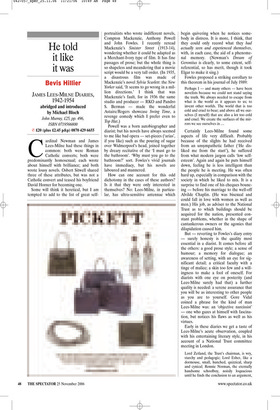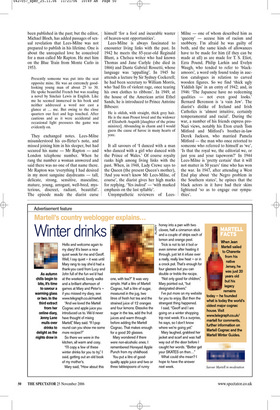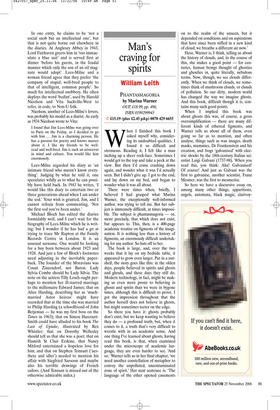He told it like it was
Bevis Hillier
JAMES LEES-MILNE DIARIES,
1942-1954
abridged and introduced by Michael Bloch John Murray, £25, pp. 496, ISBN 0719566800 ✆ £20 (plus £2.45 p&p) 0870 429 6655 Cardinal Newman and James Lees-Milne had these things in common: both were Roman Catholic converts; both were predominantly homosexual; each wrote about himself with brilliance; and both wrote lousy novels. Osbert Sitwell shared three of these attributes, but was not a Catholic convert and teased his boyfriend David Horner for becoming one.
Some will think it heretical, but I am tempted to add to the list of great self portraitists who wrote indifferent novels, Compton Mackenzie, Anthony Powell and John Fowles. I recently reread Mackenzie’s Sinister Street (1913-14), wondering whether it could be adapted as a Merchant-Ivory type of film. It has fine passages of prose; but the whole thing is so shapeless and meandering that a movie script would be a very tall order. (In 1935, a disastrous film was made of Mackenzie’s novel Sylvia Scarlett: the New Yorker said, ‘It seems to go wrong in a million directions.’ I think that was Mackenzie’s fault, for in 1936 the same studio and producer — RKO and Pandro S. Berman — made the wonderful Astaire/Rogers showcase Swing Time, a revenge comedy which I prefer even to Top Hat.) Powell was a born autobiographer and diarist; but his novels have always seemed to me like bad opera — set-pieces (‘arias’, if you like) such as the pouring of sugar over Widmerpool’s head, joined together by dreary recitative of the ‘I must go to the bathroom’. ‘Why must you go to the bathroom?’ sort. Fowles’s vivid journals have immediacy, but his novels are laboured and mannered.
How can one account for this odd dichotomy in the cases of these authors? Is it that they were only interested in themselves? No: Lees-Milne, in particular, has ultra-sensitive antennae which begin quivering when he notices somebody in distress. It is more, I think, that they could only record what they had actually seen and experienced themselves, with, in each case, the aid of a phenomenal memory. (Newman’s Dream of Gerontius is clearly, to some extent, selfreferential, so has merit, though it took Elgar to make it sing.) Fowles proposed a striking corollary to this theorem in his journal of July 1989:
Perhaps I — and many others — have been novelists because we could not stand saying the truth. We always needed to escape from what is the world as it appears to us; to invent other worlds. The world that is too cold and cruel to bear; and above all we ourselves (I myself) that are also a lot too cold and cruel. We create the surfaces of the mirrors we see ourselves in ...
Certainly Lees-Milne found some aspects of life very difficult. Probably because of the slights he had received from an unsympathetic father (‘He disliked me from the start’), he suffered from what modern jargon calls ‘low selfesteem’. Again and again he puts himself down, feeling he is less intelligent than the people he is meeting. He was often hard up, especially in comparison with the society in which he liked to mix. It is a surprise to find one of his cheques bouncing — before his marriage to the well-off Alvilde Chaplin. (He was bisexual and could fall in love with women as well as men.) His job, as adviser to the National Trust as to which buildings should be acquired for the nation, presented constant problems, whether in the shape of cantankerous owners or the agonies that dilapidation caused him.
But — reverting to Fowles’s diary entry — surely honesty is the quality most essential in a diarist. It comes before all the others: a good prose style; a sense of humour; a memory for dialogue; an awareness of setting, with an eye for significant detail; a critical faculty with a tinge of malice; a skin too few and a willingness to make a fool of oneself. For diarists with one eye on posterity (and Lees-Milne surely had that) a further quality is needed: a serene assurance that you will be as interesting to other people as you are to yourself. Gore Vidal coined a phrase for the kind of man Lees-Milne was: an ‘objective narcissist’ — one who gazes at himself with fascination, but notices his flaws as well as his virtues.
Early in these diaries we get a taste of Lees-Milne’s acute observation, coupled with his entertaining literary style, in his account of a National Trust committee meeting in London.
Lord Zetland, the Trust’s chairman, is wry, starchy and pedagogic; Lord Esher, like a dormouse, small, hunched, quizzical, sharp and cynical; Ronnie Norman, the eternally handsome schoolboy, noisily loquacious until he finds the conclusion to an argument, when he stops like an unwound clock; Nigel Bond, dry, earthy, sound, unimaginative; Sir Edgar Bonham Carter, twisted by arthritis, fair, impartial, but too subdued to be heeded by the others; Mr Horne, the old, sweet-sour yet genial solicitor, who has sat in attendance ever since, as an articled clerk, he helped draft the constitution of the National Trust in 1895, now beyond his prime, and havering.
You have the feeling that these judgments, if on the waspish side, are probably fair.
Lees-Milne’s prose mastery enlivens the diaries throughout. He can be laconic:
At 8.20 I telephoned Q., who I knew would still be in bed. She answered the telephone. I said, ‘It’s me, Q.’ ‘Is it you, Terry?’ she said in a voice of unconcealed excitement. ‘No,’ I answered, and put the receiver down gently.
He can get ecstatically gushy, as when he meets Pope Pius XII in 1948, but even that afflatus is suddenly punctured by a wry observation at the end:
The Holy Father approached me. I walked towards him and fell on both knees ... he held out his hand for me to take and I just noticed the ring, as I kissed it, to have a large dark stone encircled with lesser gems, not diamonds ... All the while he smiled in the sweetest, kindliest way so that I immediately fell head over heels in love with him. [The Pope handed him a ‘not very expensive’ medal.] In turning to leave I noticed a cardinal slip into his hand, held out behind with desperately waggling fingers, another little envelope for the next guest.
Humour is ever-present. Occasionally you are not quite sure whether you are laughing with him or at him. In June 1942 he writes of his friend and sometime lover, James Pope-Hennessy (the royal biographer later killed by ‘rough trade’):
Jamesy said he wanted to sleep with a woman, and expressed misgivings. I said it was as easy as falling off a log. The moment these words were out of my mouth I realised how discouraging they must have sounded.
In 1944 Lady Sibyl Grant, the châtelaine of Pitchford Hall, Shropshire, looked ‘like a clairvoyant preserved in ectoplasm’. In 1946 Lady Hinchinbrooke was ‘like a very jolly able-bodied seaman’. In 1947 escorting Sibyl Colefax through a theatre crowd was ‘rather like bowling a hoop’. In 1948 the monde of Chips Channon and Peter Coats (nicknamed Petticoats) was no more that of Doreen Colston-Baynes ‘than the Crazy Gang would be Queen Mary’s’. In 1949 Christopher Warner, a tall, dark and handsome friend of Lees-Milne’s future wife, was ‘a tea-leaf-fortune-teller’s delight’. James Pope-Hennessy figures again in a comical diary entry of October 1949:
Jamesy amused me by telephoning. ‘You know the picture of an 18th-century house which I am leaving to you in my will?’ ‘Yes,’ I answered. ‘Well, I am ringing you up to say that I have sold it and it is in Appleby’s shop window if you want to buy it.’
Quite often Lees-Milne is relaying the wit of others. In 1942 Winston Churchill’s niece Clarissa, who later married Anthony Eden, told him that General Pope-Hennessy (‘Jamesy’s’ father) had died after a seizure brought on by his rage at some colonel’s assertion that Russian tanks were bad. She added that Cecil Beaton had commented (enlisting a wartime slogan), ‘Careless talk costs lives.’ In 1944 Lees-Milne recalls Lord Berners’s definition of Sibyl Colefax’s and Emerald Cunard’s parties: ‘The first was a party of lunatics presided over by an efficient trained hospital nurse, the second a party of lunatics presided over by a lunatic.’ His boss Lord Esher steadfastly called him Lees-Milne. ‘ “If we were on Christian name terms,” he said, “it would be awkward if I had to sack you.” ’ The aesthete Lees-Milne could be very tough when he chose. Every few pages there is a glint of steel. In 1942, when the former prime minister Lloyd George announces that he does not give a damn about the Queen Anne house of Bradbourne, Kent, ‘or for any country house for that matter’, Lees-Milne ‘cast such intense looks of hatred and indignation at him that he was obliged to notice them’. The same year, he is ‘livid with rage’ when he sees William IV railings being removed from outside Brooks’s Club to help the war effort; he sends furious telegrams to the club secretary, to Lord Ilchester and to the architect Professor Albert Richardson. In 1943 he is thrown into ‘a paroxysm of rage’ by the news that Rome has been bombed. In March 1945 he is furious when Lord Margesson (formerly Secretary of State for War) quotes Churchill as claiming that the Polish settlement was wise and beneficent. ‘Red in the face, I exclaimed, “Beneficent, my foot! Expedient doubtless ...” ’ In his National Trust job, too, he made his views forcefully clear. He was dead against the ‘museumisation’ of country houses. In 1946, accompanied by Sir George Mallaby, he had an interview with a Ministry of Works official called Robinson.
Briefly, [Robinson] postulated that the government were just as fit persons to hold country houses as the National Trust, if it was a case of their having to provide funds. Mallaby, being a civil servant, was about to agree, but I gave him no chance to do so, interjecting, ‘By heaven, you’re not!’
Lady Astor was quite right when she said to Lees-Milne in 1947, ‘You are in earnest and you feel passionately, and I like that.’ A large proportion of these diaries has been published in the past; but the editor, Michael Bloch, has added passages of sexual revelation that Lees-Milne was not prepared to publish in his lifetime. One is about the unrequited love he conceived for a man called Mr Rapton. He met him on the Blue Train from Monte Carlo in 1953.
Presently someone was put into the seat opposite mine. He was an extremely goodlooking young man of about 25 to 30. He spoke beautiful French but was reading a novel by Sinclair Lewis in English. Like me he seemed immersed in his book and neither addressed a word nor cast a glance at ... me. But owing to the close quarters our feet and legs touched. After cautious and as it were accidental and occasional light pressures the game was evidently on.
They exchanged notes. Lees-Milne misunderstood his co-flirter’s note, and missed joining him in his sleeper, but had secured his name — Mr Rapton — and London telephone number. When he rang the number a woman answered and said there was no one of that name there. Mr Rapton was ‘everything I had desired in my most sanguine daydreams — tall, delicate, strong, sensitive, masculine, mature, young, arrogant, well-bred, mysterious, discreet, radiant, beautiful’. The episode made the diarist curse himself ‘for a fool and incurable waster of heaven-sent opportunities’.
Lees-Milne is always fascinated to encounter living links with the past. In 1942 he meets the 85-year-old Reginald Blunt, a Chelsea writer who had known Thomas and Jane Carlyle (she died in 1866) and Dante Gabriel Rossetti, whose language was ‘appalling’. In 1945 he attends a lecture by Sir Sydney Cockerell; he had been secretary to William Morris, who ‘had fits of violent rage, once tearing his own clothes to ribbons’. In 1949, at the house of the American artist Ethel Sands, he is introduced to Prince Antoine Bibesco:
He is oldish, with straight, thick grey hair. He is the man Proust loved and the widower of Elizabeth Asquith [daughter of the prime minister]. Abounding in charm and I would guess the cause of havoc in many hearts of yore.
It all savours of ‘I danced with a man who danced with a girl who danced with the Prince of Wales.’ Of course royalty ranks high among living links with the past. When, in 1948, Lady Crewe says to the Queen (the present Queen’s mother), ‘And you won’t know Mr Lees-Milne, of course’, the diarist gives her high marks for replying, ‘Yes indeed’ — ‘with marked emphasis on the last syllable’.
Unsympathetic reviewers of Lees Milne — one of whom described him as ‘queeny’ — accuse him of racism and snobbery. I’m afraid he was guilty of both, and the same kinds of allowances have to be made for him (if they can be made at all) as are made for T. S. Eliot, Ezra Pound, Philip Larkin and Evelyn Waugh, who tended to refer to ‘blackamoors’, a word only found today in auction catalogues in relation to carved wooden figures. So we find ‘thick ugly Yiddish lips’ in an entry of 1942; and, in 1946: ‘The Japanese have no redeeming qualities — not even good looks.’ Bernard Berenson is ‘a vain Jew’. The diarist’s dislike of Ireland and Irish Catholics is ‘almost intuitive, certainly temperamental and racial’. During the war, a number of his friends express proNazi views, notably his Eton crush Tom Mitford and Mitford’s brother-in-law Derek Jackson, who married Pamela Mitford — the man who once retorted to someone who referred to himself as ‘we’, ‘Is that the royal we, the editorial we, or just you and your tapeworm?’ In 1944 Lees-Milne is ‘pretty certain’ that it will not matter in 50 years’ time who has won the war. In 1947, after attending a West End play about ‘the Negro problem in the Southern states’, he opines that the black actors in it have had their skins lightened ‘so as to engage our sympathies’. In one entry, he claims to be ‘not a social snob but an intellectual one’, but that is not quite borne out elsewhere in the diaries. At Anglesey Abbey in 1943, Lord Fairhaven greets him in ‘too immaculate a blue suit’ and is served first at dinner ‘before his guests, in the feudal manner which only the son of an oil magnate would adopt’. Lees-Milne and a woman friend agree that they prefer ‘the company of stupid, well-bred people to that of intelligent, common people’. So much for intellectual snobbery. He often deploys the word ‘bedint’, used by Harold Nicolson and Vita Sackville-West to refer, in code, to Non-U folk.
Nicolson, another of Lees-Milne’s lovers, was probably his model as a diarist. As early as 1934 Nicolson wrote to Vita:
I found that Jim Lees-Milne was going over to Paris on the Friday, so I decided to go with him ... Jim is a charming person. He has a passion for poetry and knows masses about it. I like my friends to be wellread and well-bred. Jim is such an aristocrat in mind and culture. You would like him enormously.
Lees-Milne regarded his diary as ‘an intimate friend who mustn’t know everything’. Judging by what he told it, one speculates wildly as to what he can possibly have held back. In 1943 he writes, ‘I would like this diary to entertain two or three generations ahead when I am under the sod.’ Your wish is granted, Jim, and I cannot refrain from commenting, ‘Not the first sod you’ve been under.’ Michael Bloch has edited the diaries formidably well, and I can’t wait for the biography of Lees-Milne which he is writing; but I wonder if he has had a go at trying to trace Mr Rapton at the Family Records Centre in London. It is an unusual surname. One would be looking for a boy born between about 1923 and 1928. And just a few of Bloch’s footnotes need adjusting in the inevitable paperback. The founder of the Moravians was Count Zinzendorf, not Baron. Lady Sylvia Combe should be Lady Silvia. The note on the actress Tilly Losch ought perhaps to mention her ill-starred marriage to the millionaire Edward James; that on Alice Harding, describing her as ‘muchmarried Astor heiress’ might have recorded that at the time she was married to Philip Harding (a schoolfriend of John Betjeman — he was my first boss on the Times in 1963); that on Simon HarcourtSmith could have alluded to his book The Last of Uptake, illustrated by Rex Whistler; that on Dorothy Wellesley should tell us that she was a poet; that on Hamish St Clair Erskine, that Nancy Mitford entertained a hopeless love for him; and that on Stephen Tennant (‘aesthete and idler’) needed to mention his affair with Siegfried Sassoon and maybe also his terrible drawings of French sailors. (And Tennant is missed out of the otherwise admirable index.)





























































































 Previous page
Previous page